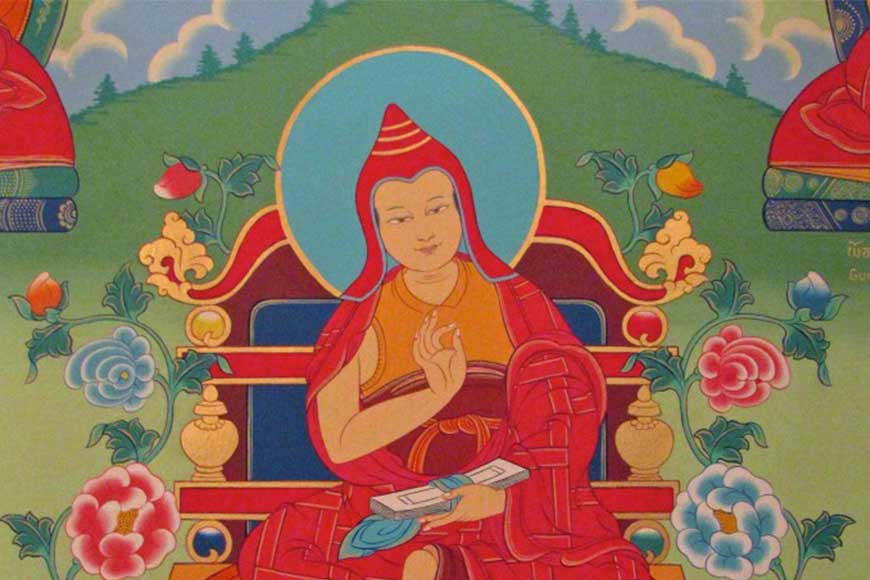Shantarakshita, Bengali Prince-turned-monk spread Buddhism even before Atish Dipankar

Atiśa Dīpankara Śrījñāna, (982–1054) , the renowned Buddhist religious leader and master from Bengal was one of the major figures in the spread of 11th century Mahayana and Vajrayana Buddhism in Asia and inspired Buddhist thought from Tibet to Sumatra. He is recognised as one of the greatest figures of classical Buddhism. But prior to him, in the 8th century, Shantarakshita, a Bengali prince turned monk and illustrious scholar from Nalanda University, visited Tibet and founded the monastic order there.
Shantarakshita’s student Kamalashila also visited Tibet to uphold Buddhism. So, we can safely say that Shantarakshita was the first explorer from Bengal who took Buddhism to Tibet. The history of Buddhism spans from the 6th century BCE to the present. Buddhism arose in the eastern part of ancient India, in and around the Kingdom of Magadha. The religion evolved as it spread from the northeastern region of the Indian subcontinent through Central, East, and Southeast Asia. At one time or another, it influenced most of the Asian continent.
The Shunga dynasty (185–73 BCE) was established about 50 years after Ashoka's death and Pushyamitra Shunga took the throne. Buddhist religious scriptures such as the Aśokāvadāna allege that Pushyamitra (an orthodox Brahmin) was hostile towards Buddhists and persecuted the Buddhist faith. Buddhists wrote that he ‘destroyed hundreds of monasteries and killed hundreds of thousands of innocent monks.’ Buddhism flourished under the Indo-Greek and Greco-Bactrian kings. One of the most famous Indo-Greek kings is Menander (reigned c. 160–135 BCE). He may have converted to Buddhism and is presented in the Mahāyāna tradition as one of the great benefactors of the faith, on a par with king Aśoka or the later Kushan king Kaniśka. During Kushan rule ((30–375 CE), Gandharan Buddhism was at the height of its influence and a significant number of Buddhist centers were built or renovated. Emperor Kanishka (128–151 CE) is particularly known for his support of Buddhism. Buddhism continued to flourish in India during the Gupta Empire (4th–6th centuries) which brought order to much of North India.
A 19th century painting higlighting Shatarakhshita's journey to Tibet
After the fall of Harsha's empire, the Gangetic plain saw the rise of many small feuding kingdoms. This was to last until the rise of the Pāla Empire (8th–12th centuries) in the Bengal region. Pala Dynasty ruled Bengal and Bihar for about four centuries from the middle of the 8th century AD. Founded by Gopala, the rule of the dynasty underwent various vicissitudes and lasted for 18 generations of kings.
The Pālas were staunch supporters of Buddhism, and built several important Buddhist centers, such as Vikramashila, Somapura and Odantapuri. They also supported older centers like Nalanda and Bodh Gaya. Great Buddhist scholars such as Santaraksita and Atisha date from this period. Under the Pālas, Mahāyāna Buddhism thus flourished and spread to Tibet, Bhutan and Sikkim.
Santaraksita was a Buddhist religious Abbot. He was one of the major figures in the spread of Vajrayana Buddhism in Tibet. Little is known of Śāntaraksita's earlier life in India. Tibetan sources indicate that he was born in 725 AD, during the reign of the first Pala ruler, Gopala, in a royal family in Zahor — a locale identified variously by modern scholars with sites in Bengal, Bihar, and Pakistan but a majority of scholars identify the place to be in modern-day Bikrampur area of Dhaka. He went to Nalanda and became the disciple of the great scholar, Gnyangarvi Pundit. He was at Nalanda when he was formally declared as Bodhisattwa. Later he became the abbot of the famous Nālandā monastic university. Although this cannot be confirmed, there is no doubt that Śāntaraksita was a remarkably erudite scholar who was deeply versed in a wide range of Indian dialectical traditions. He died in 788 Ad in Tibet, during Dharapala’s reign.
Śāntarakṣita was brought to Tibetan Empire at the request of Emperor Trisong Detsen sometime before 767 CE. One account details his first trip as unsuccessful and he spent six years in Nepal before returning to Tibet. He made his second and final trip to Tibet and ultimately spent the last 15 years of his life there. Śāntarakṣita was one of the most influential figures in the early dissemination of Buddhism in Tibet, founding the first Buddhist monastery at Samyé (bsam yas), serving as its first abbot, ordaining the first seven Tibetan monks, and establishing a system of rigorous philosophical study based upon the traditions of learning at the great Indian Buddhist monastic universities such as Nalanda and Vikramaśīla.
He wrote 11 books including Tattvasaṃgraha (Collection of Realities), Ashta Tathagata Stotra, Vajradhan Sangeet Bhagavat Stotra Teeka, Tattwasangraha Karika, Hevajra Uddhav Kurukulah Pancha Mahaopadesh, Tathasiddhi Naam Prakarn, Vibhanga Panjika, Madhymak Alankar Karika, Vadhyanaya Vitthi and Danda Hastalekha.
Śāntarakṣita's major works are preserved in Sanskrit and they reveal the extent of his learning. He was a dynamic thinker and a scholar with both breadth and depth of knowledge of the Indian philosophical traditions. He encouraged his readers to actively engage with a host of non-Buddhist and Buddhist philosophical positions as they ascended a sort of hierarchy of philosophical views, a hierarchy that—in his opinion—culminates in the Madhyamaka view.
Śāntarakṣita was instrumental in the introduction of Buddhism and the Sarvastivadin monastic ordination lineage to Tibet which was conducted at Samye. His philosophic views were the accepted perspective in Tibet from the 8th century until it was mostly supplanted by Je Tsongkhapa's interpretation of Prasaṅgika Madhyamaka in the 15th century. In the late 19th century, Ju Mipham attempted to promote his views again as part of the Rimé movement and as a way to discuss specific critiques of Je Tsongkhapa's interpretation of Prasaṅgika.
It is a pity that we have chosen to forget this great scholar and explorer who was instrumental in spreading Buddhism outside the borders of the country.










